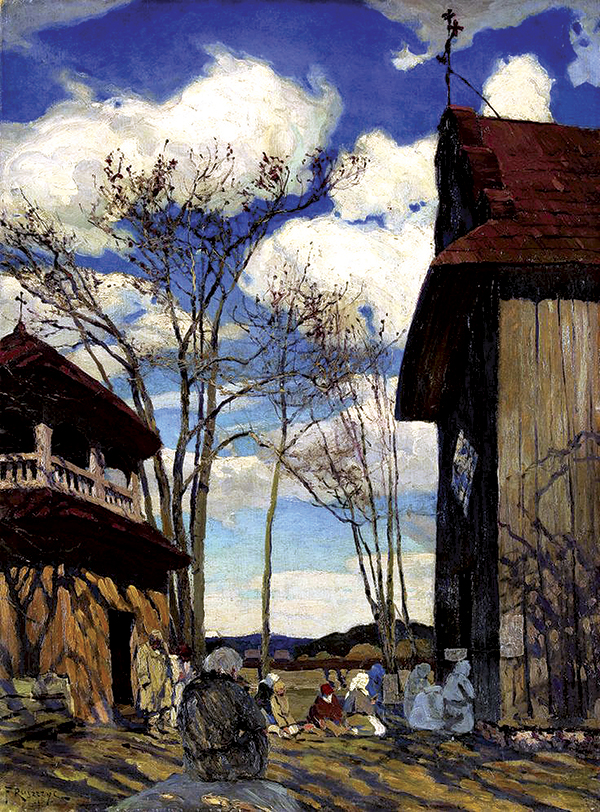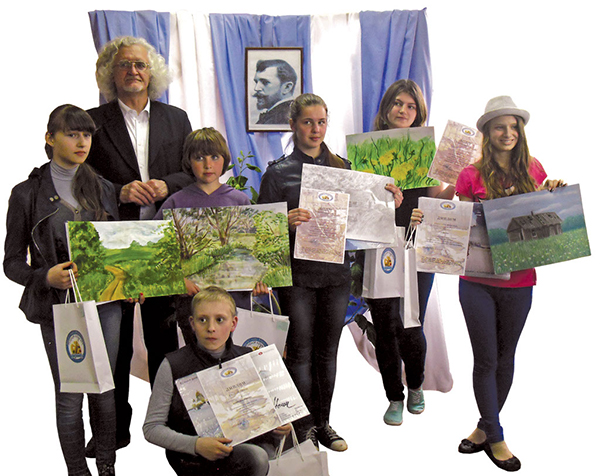 Although born on December 10th, celebrations have already launched in Belarus for the great artist’s anniversary. An open air workshop was recently organised in Volozhin District, featuring such talents as Kastus Kochan, Ales Susha, Vladimir Vasuyk, Igor Barkhatkov, Alexander Lubnevsky, Vladimir Prokoptsov, Alexander Grishkevich and Vladislav Petrik, with works donated to Bogdanovo.
Although born on December 10th, celebrations have already launched in Belarus for the great artist’s anniversary. An open air workshop was recently organised in Volozhin District, featuring such talents as Kastus Kochan, Ales Susha, Vladimir Vasuyk, Igor Barkhatkov, Alexander Lubnevsky, Vladimir Prokoptsov, Alexander Grishkevich and Vladislav Petrik, with works donated to Bogdanovo.
Ruszczyc was a true personality of whom many are only just learning, thanks to such events as those being run by the National Art Museum and Volozhin District Executive Committee.
Participants of the workshop will return to Bogdanovo on December 10th for more celebrations. Meanwhile, local residents are tidying the Ruszczyc family graves, and are creating an exhibition devoted to the artist at the Bogdanovo branch of the Vishnevka children’s arts school.
A workshop for young artists has been organised, alongside the Land and Sky of Ferdinand event and the Night of Museums at the local history museum. Guests from the Ferdynand Ruszczyc Gymnasium (Lithuania, Rudamina) arrived, helping raise the event to international status.
Interestingly, several years ago, the name of Ruszczyc was little known in Belarus; only art experts were familiar with his works, as indicated by a poll conducted by Alla Makarevich, a teacher at Volozhin’s secondary school #1. Since then, Ruszczyc’ artistry has been more widely promoted. Alla herself was once ignorant of the artist’s legacy.
 |
|
Ruszczyc urodził się w Bohdanowie w 1870 roku. Uczył się w gimnazjum w Mińsku, a następnie studiował w Akademii Sztuk Pięknych w Sankt Petersburgu u Szyszkina i Kuindży
|
Ruszczyc was born in Bogdanovo in 1870. He studied at Minsk’s gymnasium and later attended the St. Petersburg Academy of Arts (taught by Shishkin and Kuindzhi) and became a member of the famous World of Art Russian Artistic Association and the Polish Union of Artists — Sztuka.
In 1921, Ferdinand organised the first exhibition of Polish artists in Paris and was awarded by the French Order of Honorary Legion. Ruszczyc painted posters, illustrated books and made decorations for theatrical shows — mostly in Vilno. In fact, the artist spent most of his life in Bogdanovo and Vilno.
From 1908-1915, he lived at Vilno’s 24 Užupis Street — in the house owned by the Łaskarys family (of whom Polish poet Jerzy Łaskarys was a member). In Užupis (Zarzecze), almost every stone reminds you of Ruszczyc, as his voice was heard at St. Baltrameus’ Roman Catholic Church in the autumn 1913, when he married there. Services at this church are now held in Belarusian.
From autumn 1915 to March 1919, Ruszczyc lived in Bogdanovo and then — when the Poles occupied Vilno — he organised and headed a department of fine arts at the local university. The department was located within the former Bernardine Monastery, at 6 Maironio Street (the building now has a plaque honouring the artist). Moreover, the establishment is still operational, as the local Art Academy. At various times, it has nurtured such Belarusian artists as Piotr Sergievich and Michal Sevruk, and photographer Denis Romanyuk.
Ruszczyc loved to paint landscapes, and produce sets for Vilno theatres, as well as illustrating books and painting posters. In late 2013, the 100th anniversary of Belarusian posters was celebrated, honouring Ruszczyc’ poster advertising the 1st District Exhibition of Folk Art (held in Vilno in September 1913).
From 1923 to 1935, Ruszczyc lived at Vilno’s 22 Piles Street. Interestingly, between 1811 and 1814, and between 1817 and 1828, Polish poet Juliusz Słowacki had lived at this address. In 1927, a bust sculpted by Bolesław Bałzukiewicz was unveiled on the house façade, at Ruszczyc’ initiative.
On October 28th, 1932, the artist suddenly lost the ability to speak and found his right hand paralysed. In 1935, he returned to Bogdanovo and, a year later, died: aged 66. A monument to the great man is installed in Bogdanovo, on the hill. Sadly, his home failed to survive. Meanwhile, a street named after Ruszczyc has existed in Minsk since 2002.
In Vilno, works by this Belarus-born artist are on show at the Lithuanian Art Museum and at the Academy of Sciences’ library (his 1895 landscape, Krevo Castle, is kept there).

Zwycięzcy V pleneru-konkursu młodych pejzażystów “Ziemia i niebo Ferdynanda Ruszczyca” razem z szefem jury Władimirem Prokopcowem
Until recently, Belarus had only one picture by Ruszczyc, held near the Roman Catholic Church, and depicting Bogdanovo’s church, which no longer stands. The canvas is currently on show at the National Art Museum. In 2015, Belgazprombank bought Ruszczyc’ Vilia and his Bread and Stack Stand, for its corporate collection: each depicts a Bogdanovo landscape, showing how greatly he loved his homeland.
Ms. Makarevich dreams of establishing a large museum exhibition devoted to Ruszczyc, in Bogdanovo and Volozhin, and has already collected many books on the artist, which are unique in Belarus. Among them are editions purchased abroad.
The painter’s grandson (also called Ferdynand Ruszczyc) is a well-known museum expert in Poland and, some time ago, visited Minsk. He noted, “I’m doing everything possible to visit the homeland of my grandfather at least once a year. I bring my friends and relatives, to show them our roots, of which I’m proud.”
The spirit of Ruszczyc is strong in Bogdanovo and it’s hoped that his old home and the Roman Catholic Church may yet be rebuilt, and a monument to Ferdinand erected. Having united Belarus with its neighbours, he deserves to be remembered
By Viktar Korbut











